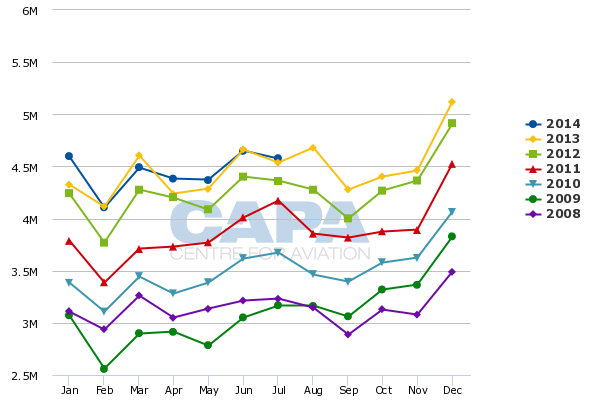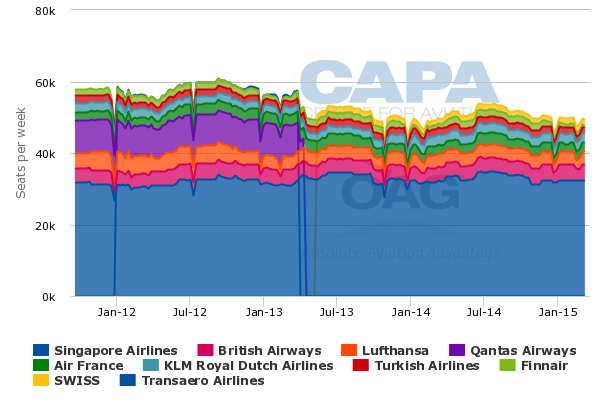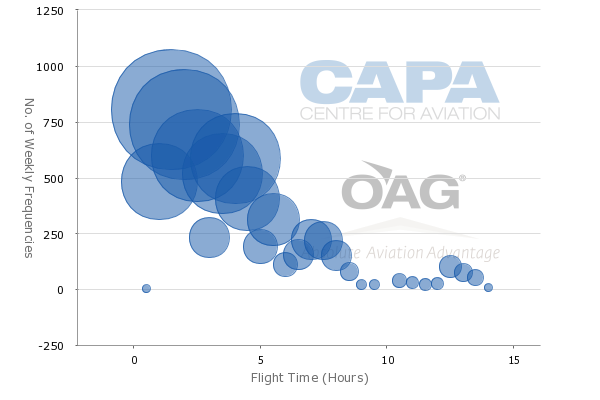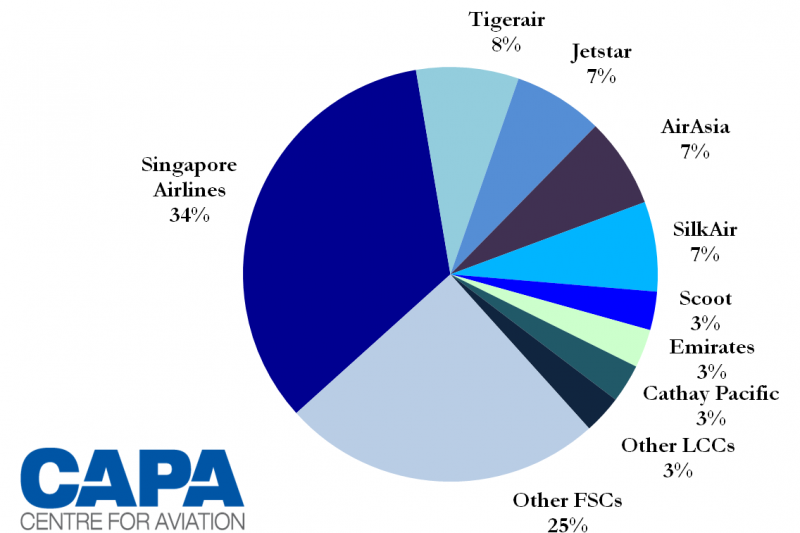Singapore outlook Part 3: long-haul growth is unlikely. LCC-led transfer growth is what's needed
Singapore Changi Airport and CAAS are trying to promote new long-haul flights and more transit traffic in response to a significant slowdown in passenger growth. Singapore is eager to drum up new sources of traffic or growth as it invests significantly in airport expansion which will prove to be overly ambitious if growth cannot be restored.
Incentivising transit traffic is logical as a growth in transit numbers, long a staple under Singapore's hub strategy, could help offset a recent drop in inbound visitor numbers. Following Kuala Lumpur's example, Singapore will probably need to focus on enhancing LCC transit traffic, an increasingly important segment which Changi has barely scratched.
Long-haul transit traffic growth will be much harder to achieve, even with incentives. Changi's biggest growth opportunities are likely on medium-haul routes and connections within Asia-Pacific.
- Singapore Changi Airport and CAAS are implementing incentive programs to stimulate traffic growth in response to a slowdown in passenger growth.
- The focus is on promoting transit traffic and long-haul flights, with a particular emphasis on enhancing low-cost carrier (LCC) transit traffic.
- Changi Airport has experienced a decline in long-haul traffic, particularly to Europe, and is facing challenges in growing this segment.
- The airport is offering incentives such as rebates on landing fees, parking fees, and aerobridge fees to attract more long-haul flights.
- The airport is also targeting transit traffic growth by offering incentives to airlines for increasing the number of departing transit passengers.
- LCCs like Scoot, Tigerair, and Jetstar Asia are expected to benefit from these initiatives and play a significant role in driving transit traffic growth.
CAPA's Asia Aviation Summit and LCC Congress will he held at the Capella, Sentosa in Singapore 13/14 October, followed by a Corporate Travel Day on 15 October. To hear about all of Asia's key aviation markets and players, and meet 20 airline CEOs, click here: CAPA Asia Aviation Summit
This is the third instalment in a series of reports on the Singapore market. The first report analysed the slowdown in growth and lack of profitability in Singapore's LCC sector. The second report looked at the slowdown in growth and profits at SIA regional full-service subsidiary SilkAir.
This report focuses on Singapore's efforts to stimulate growth in the long-haul and transit sectors.
See related reports:
- Singapore outlook Part 2: SilkAir slows its expansion. Strategic adjustments may be necessary
- Singapore LCCs: growth slows and penetration rate falls as Jetstar Asia & Tigerair incur losses
Singapore starts to respond to slowing traffic growth
The Civil Aviation Authority of Singapore (CAAS) and Changi Airport have unveiled various incentive programmes in recent months aimed at trying to stimulate traffic growth. Growth at Changi has fallen significantly since 2012, which marked the third consecutive year of double-digit passenger growth.
Passenger numbers were up a more modest but still relatively healthy 5% in 2013. Traffic expansion has fallen further so far in 2014, with growth of only 1.3% through the first seven months.
Changi even recorded rare year-over-year declines in two months of this year. Changi had not seen a monthly drop in traffic since 2009, when annual traffic declined due to the global financial crisis.
Changi Airport monthly passenger numbers: Jan-2008 to Jul-2014
As CAPA pointed out in the first two reports in this series, LCCs have accounted for about 75% of Changi's growth since 2007 while SilkAir has accounted for about another 10%. Singapore Airlines traffic has remained relatively flat during this period. The remaining 15% has been generated primarily by Gulf carriers and to some extent full-service airlines from Asia.
Singapore sees reduction in long-haul traffic
Singapore has always placed a big emphasis on long-haul traffic, which it views as a critical component for maintaining its status as a global hub. But long-haul traffic at Changi has been on the decline in recent years.
Changi lost its only non-stop connections to North America in 2013 while capacity to Europe has fallen by about 10% over the past two years. Changi recorded a 5% drop in passenger traffic on non-stop European routes in 2013.
Singapore to Europe total capacity (one-way seats per week): 19-Sep-2011 to 15-Mar-2015
Besides Europe the only long-haul routes from Changi are Auckland, Christchurch and Johannesburg. Capacity to New Zealand and South Africa has been relatively flat over the past few years. (New Zealand will show a slight rise in 2015 as the Singapore-Auckland route is upgraded from 12 weekly SIA flights to seven weekly A380 SIA flights and seven weekly Air New Zealand flights under a new JV between SIA and Air NZ. But the JV has driven away Jetstar, which recently dropped its thrice weekly A330 service from Singapore to Auckland.)
Several Australia, Japan and Middle East routes are seven or eight hours. These do not meet Changi's definition of long-haul, which is nine hours or more.
Singapore Changi frequencies by flight time: 15-Sep-2014 to 21-Sep-2014
Changi faces an uphill battle in growing Europe traffic
In early Sep-2014 Changi announced a 50% rebate on landing fees on all long-haul flights over the next 19 months. This is one of several initiatives under Changi's new SGD100 million (USD80 million) Growth and Assistance Incentive (GAIN) programme.
SIA and European carriers will obviously benefit from the rebate as well as Air NZ, which was already planning to resume services to Singapore in late 2014 or early 2015 as part of its new joint venture with SIA. But the scheme is unlikely to attract a significant increase in traffic, which is the intention of the GAIN programme.
Attracting a new European carrier is difficult. European airlines are generally conservative with long-haul expansion and Singapore is not usually as attractive as opportunities in emerging markets such as China.
There are also hardly any potential new entries from Europe, as Finnair (2011) and Swiss (2013) have already started or resumed Singapore services in recent years. Air France, British Airways, KLM Lufthansa and Turkish also already serve Singapore.
European expansion from SIA is also unlikely as the airline has been focusing on expanding within Asia-Pacific. SIA plans to only increase mainline ASKs by 1% in the fiscal year ending 31-Mar-2015 - hardly providing room for the potential launch of a new long-haul route.
Africa remains a challenging market for Singapore
Africa poses an intriguing alternative and is a market being targeted by Changi. But Ethiopian Airlines seems content at least for now on serving Singapore via Bangkok, which it launched in late 2013. Singapore is not currently on the radar screen of Kenya Airways or any other African carrier.
Africa is a tiny source market for Singapore, with only 30,000 African residents visiting Singapore in the first seven months of 2014, according to Singapore Tourism Board data. This represents less than 0.5% of total visitor traffic that arrives in Singapore by air.
Changi sees the potential of developing Singapore into a hub for broader Africa-Asia flows. Ethiopian for example is using Changi and its partnership with Singapore Airlines to access Australia and New Zealand. But Asia-Africa traffic via Singapore will not be easy to develop and Ethiopian's one-stop product to Singapore provides rather inconvenient two-stop connections for the rest of Asia-Pacific (and three stops if originating or heading to African destinations other than Ethiopia).
Bangkok continues to have a huge advantage with several non-stops from Africa and better connection times to Asia, particularly in the large and fast growing Africa-China market.
See related report: Ethiopian Airlines to give Singapore Changi and Singapore Airlines an important link to Africa
Changi and CAAS offer several initiatives and incentives
The GAIN programme also includes 50% rebates on parking fees and a 15% discount on aerobridge fees. These were initially outlined in Jun-2014 when the programme was first announced while the 50% discount on landing fees for long-haul flights as well as an incentive for transit traffic growth were outlined in early Sep-2014. The parking fee rebates and aerobridge fee discounts have been in place since 1-Jul-2014 and will be in effect for one year.
As CAPA highlighted in Jun-2014, the parking rebates will generally benefit long-haul carriers as Changi does not charge for parking unless an aircraft is parked for at least three hours. The aerobridge reduction in theory will benefit a wider group but the 15% discount is not very substantial. LCCs for example will only save SGD14 (USD11) per flight as Changi charges SGD165 (USD132) for a 180-seat A320 as long as the aerobridge is used three hours or less. (For airlines using an aerobridge for over three hours they must pay an additional hourly rate equivalent to the rate for the first three hours.)
In Jul-2014 CAAS also unveiled its own SGD100 million (USD80 million) programme aimed at improving Changi's productivity through two initiatives that will be funded through Mar-2018. These are designed to incentivise the acquisition of more efficient ground equipment and automate baggage loading and unloading. The CAAS also had pledged to absorb SGD50 million (USD40 million) in air navigation service charges over the next two years - these charges are now paid for by Changi but the savings are to be passed to airlines.
Airlines generally are not convinced the SGD250 million (USD200 million) in initiatives will have much of an impact at stimulating traffic and believe Changi should instead be focusing on broader permanent improvements aimed at improving the airport's competitiveness compared to other hubs in the region. As CAPA previously outlined, airlines serving Changi have long complained about the overall high cost of operating out of the airport.
See related report: Singapore Changi's slowdown requires long-term strategic solutions, improved transfer traffic model
In particular, several airlines would prefer Changi and Singapore to focus on fixing the underlying issue of structurally higher costs. This has particularly become an issue among the LCCs. Some LCCs serving Changi are frustrated that most of the incentives and rebates focus on the long-haul market and in some cases their costs are actually increasing as other earlier rebates from which they benefitted have expired. Some of the LCCs expecting to benefit also see the incentives as a temporary solution that merely deflects attention away from trying to solve longer-term challenges.
Changi tries to boost transit traffic
The fourth and final component under GAIN, incentivising transit traffic, has the best chance at stimulating growth. But this is also a short-term strategy and will only be in effect for 18 months, from 1-Oct-2014 to 31-Mar-2016.
The transit traffic incentive will provide airlines with SGD10 per incremental departing transit passenger over the 18-month period. However there is a per airline cap of SGD3 million (USD2.4 million) for the duration of the programme. The initiative, which will apply to both codeshares and interlines, is aimed at encouraging airlines to adjust their fares and revenue management models to stimulate growth.
Several airlines will likely benefit from this scheme, particularly Singapore's LCCs. They have already been pushing to grow transit traffic and the example offered by nearby Kuala Lumpur International Airport (KLIA) resounds loudly. The Singapore point to point LCC market is relatively mature and, as CAPA outlined in the first report in this series, short-haul LCCs have struggled over the past year as they have continued adding capacity rapidly.
Increasing transit traffic - internally and with partners - is essentially the only source for further growth in the Singapore short-haul LCC sector. For Scoot transit traffic is particularly important as the long-haul low-cost model struggles to survive without feed.
Scoot and Tigerair focus on transit traffic
Scoot, which launched services in Jun-2012, so far has had to get by with very limited transit traffic. But Scoot is now starting to increase cooperation with Tigerair following Aug-2014 approval from Singapore's competition commission.
Tigerair Singapore and Scoot are targeting 600,000 annual transit passengers. This is the equivalent of about 30% of Scoot's total passenger traffic and slightly over 10% of Tigerair Singapore's traffic. These are realistic targets given that AirAsia X-AirAsia connections currently account for more than 35% of AirAsia X traffic. Overall transit traffic now accounts for just over 50% of total passenger traffic at AirAsia X (based on 2Q2014 figures), including AirAsia X-AirAsia X connections.
See related reports:
- AirAsia X drives 43% transit traffic at Kuala Lumpur's KLIA. Can Singapore follow the same recipe?
- AirAsia X records 2Q2014 loss as Australia underperforms. But long-term prospects are still bright
Even if Scoot and Tigerair fall 30% short of their target they will each qualify for the maximum SGD3 million allowed under the new Changi transit traffic incentive scheme. And that excludes likely growth in transit traffic within their own operations (i.e. Tigerair to Tigerair or Scoot to Scoot connections) and with other partners.
When factoring in these sources, including Tigerair's new partnership with Cebu Pacific, incremental transit growth at each carrier could easily be over 500,000 passengers per year.
Transit traffic is not new for Jetstar Asia but there is further growth potential
Jetstar Asia should also benefit from the new scheme as it recently implemented a new codeshare with Emirates which has so far generated encouraging numbers and has potential for rapid growth. While Tigerair only launched a connection product in early 2013 (with very limited take up so far), Jetstar Asia's model has for several years included a focus on connecting passengers. Jetstar has been achieving a rate of at least 15% of its Singapore passengers connecting - either within Jetstar or to other carriers.
Neither Changi nor Jetstar has provided transit traffic figures since the 15% figure was provided three years ago. But it is likely Jetstar Asia's transit traffic has continued to grow at least slightly, driven over the past year by an improvement in connections with Qantas following a retiming of Qantas flights to Singapore from Brisbane, Melbourne and Sydney. (Previously Jetstar Asia-Qantas connections were limited as Qantas' Singapore flights had been timed to connect to Qantas' Singapore-Europe services, which were terminated in 1H2013 as the stopover on Qantas' European flights moved to Dubai.)
Jetstar Asia should be able to continue growing its transit traffic at Changi, driven mainly by Emirates but also continued improvements in its partnership with parent Qantas. Jetstar Asia also currently has 14 interline partners, including 11 which serve Singapore.
Transit traffic growth opportunities are there for Changi
Overall, transit traffic accounts for roughly 30% of total traffic at Changi. But most of this comes from SIA and SilkAir, which rely on transit passengers for about 50% of their total traffic. SIA and SilkAir currently have about a combined 41% share of seat capacity in the Singapore market.
SIA and particularly SilkAir, which has been growing rapidly while SIA has been stagnant, can potentially further boost transit traffic at Changi and be beneficiaries of the new incentive scheme. But clearly the biggest opportunity for transit growth is in the LCC sector, which accounts for about 28% of total capacity in Singapore. And although LCC expansion has recently slowed, history suggests that this will be where the future high growth rates will be.
Scoot/Tigerair currently have a combined 11% share of seat capacity in Singapore. Jetstar has about a 7% share but this rises to about 12% when including its two close partners, Emirates and Qantas.
Singapore capacity share (% of seats) by brand: Sep-2014
LCCs can play an important role in providing feed to Singapore's long-haul carriers. In fact Jetstar Asia already works with all seven European carriers serving Changi, testament to how difficult it can be to access seats on SIA and SilkAir as the SIA Group pushes its own connections. But the biggest growth opportunities are within Asia-Pacific, particularly medium-haul connections as Scoot expands.
Changi needs such new sectors to fill its future complex of terminals and third runway, which is slated to be completed early next decade and to have capacity for up to 170 million passengers per annum. Changi's current capacity is 85 million passengers per year, a figure it was on track to reach by 2020 before the recent slowdown. It is now unlikely that Changi, which will handle about 55 million passengers this year, will reach the 85 million mark until next decade.
See relate report: Singapore Changi ensures its future as leading ASEAN hub with third runway and fifth terminal
Changi needs to push transit traffic growth as the local market upside is limited
Changi also needs such new sectors as it has a relatively limited local market compared to other airports in Asia. Singapore's population is only about five million. Significant growth in population or propensity to travel, which is already high, is not likely. The inbound market is also relatively limited.
Singapore inbound visitor numbers have been on the decline this year. While this could be a temporary set back, driven by challenges in the China market, Singapore cannot rely on its own tourism sector to fill Changi's future terminals. Singapore recorded 6.88 million visitors by air in the first seven months of 2014, which represents only 22% of total Changi traffic.
Total visitor numbers by air were down by 1% compared to the first seven months of 2013 as China numbers dropped 22%. Five other major source markets were also down albeit modestly - Australia, Japan, the Philippines, the US and the UK. (The drop in Chinese figures was discussed in the previous instalment in this series of reports.)
Changi enters a critical era as it tries to reverse the recent slump in traffic; it will need more than band-aids
Singapore has always recognised the importance of establishing and maintaining a leading hub, which has helped raise its global profile. Singapore also has always recognised the crucial role of transit traffic in growing Changi and raising its profile despite its relatively small size.
Singapore has placed a big bet on its future as a hub by investing in a mega airport project that provides the infrastructure necessary for long-term rapid growth. Singapore is now taking steps to stimulate growth ahead of the construction. It however is no more than a start. The new series of incentives are for the most part temporary measures that do not address the main challenges.
Changi has just entered one of its most difficult and critical eras, with numerous and different new challenges.
There are opportunities, particularly in the LCC transit space, but it is going to take a lot more than a few million dollars in short term incentives. Innovative long-term solutions and structural changes will be required for Changi to enjoy a new phase of growth.
These are easy words to say, but sustainable solutions are not easily found. In the meantime, it needs to be recognised that temporary price incentives can be no more than a band-aid, where what is needed is major surgery.



